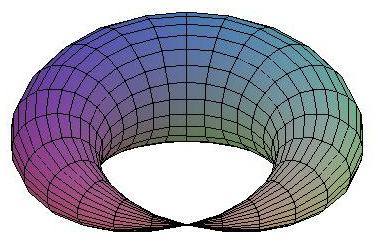 | ||
A pseudomanifold is a special type of topological space. It looks like a manifold at most of the points, but may contain singularities. For example, the cone of solutions of
Contents
A pseudomanifold can be regarded as a combinatorial realisation of the general idea of a manifold with singularities. The concepts of orientability, orientation and degree of a mapping make sense for pseudomanifolds and moreover, within the combinatorial approach, pseudomanifolds form the natural domain of definition for these concepts.
Definition
A topological space X endowed with a triangulation K is an n-dimensional pseudomanifold if the following conditions hold:
- (pure) X = |K| is the union of all n-simplices.
- Every (n – 1)-simplex is a face of exactly two n-simplices for n > 1.
- For every pair of n-simplices σ and σ' in K, there is a sequence of n-simplices σ = σ0, σ1, …, σk = σ' such that the intersection σi ∩ σi+1 is an (n − 1)-simplex for all i.
Implications of the definition
Related definitions
Examples
(Note that a pinched torus is not a normal psedomanifold, since the link of a vertex is not connected.)
